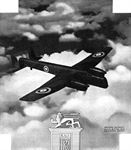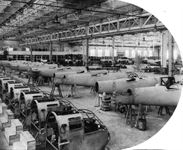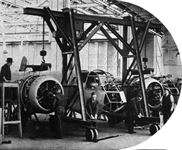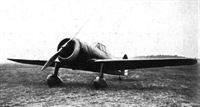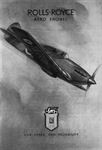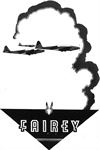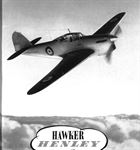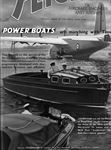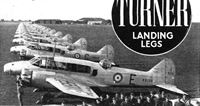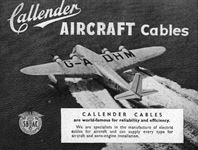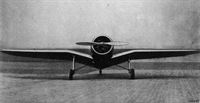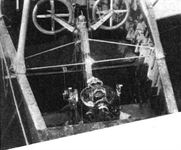Фотографии
-
The new versions of the Armstrong-Whitworth Whitley, (Marks IV and V) have Rolls-Royce Merlin engines in place of the radials of the earlier Marks. The Whitley IV is shown without its nose and tail gun turrets.
Самолёты на фотографии: Armstrong Whitworth Whitley / A.W.38 - Великобритания - 1936
-
The Blenheim was the first all-metal aircraft to go into production for the R.A.F. It is jig-built in six sections - three fuselage and three wing - all built up of light alloy, including the covering of the wings.
Самолёты на фотографии: Bristol Blenheim - Великобритания - 1936
-
The Blenheim is powered by two "Bristol" Mercury engines which are fitted to the air-frame prior to its removal from the jig by a special transportable crane. It is then ready for the attachment of the wings and tail unit.
Самолёты на фотографии: Bristol Blenheim - Великобритания - 1936
-
THE FOKKER D21: "Bristol" Mercury engine. A single-seat fighter low-wing cantilever monoplane, of steel tube framework covered with light alloy, bakelite-plywood and fabric. With balanced ailerons and tabs, split trailing-edge flaps, fixed cantilever-type divided undercarriage and brakes. Enclosed heated cockpit equipped with oxygen apparatus. Span 36 ft., length 27 1/2 ft., height 9 ft., weight loaded 4,290 lbs., max. speed at 14,500 ft., 277 m.p.h. This machine gained the Dutch altitude record at 11,353 m. (37,250 ft.) with a standard "Bristol" Mercury VIII engine. Constructed Fokker.
Самолёты на фотографии: Fokker D.XXI - Нидерланды - 1936
-
Самолёты на фотографии: Hawker Hurricane - Великобритания - 1935
-
Самолёты на фотографии: Fairey Battle - Великобритания - 1936
-
Самолёты на фотографии: Fairey Battle - Великобритания - 1936
-
Регистрационный номер: G-ADHK Самолёты на фотографии: Short Mayo Composite (S.20 Mercury and S.21 Maia) - Великобритания - 1938
-
On 27th-28th Apl., 1910, Louis Paulhan won the first actively contested air-race in history. He flew the 183 miles from London to Manchester in under the 24 hours. Leaving London in the late afternoon of the 27th, Paulhan flew in one lap to Lichfield (117 miles). At 5.32 a.m. the next morning he landed at Manchester well within the 24 hour limit allowed. By such experiments and by the pioneer work of Shell the long-distance flights of today have been made possible. Shell supplied first-grade petrol to the aerodromes which have since developed into extensive airports and so paved the way to the present standard of efficiency. By means of Shell Aviation Service and the Shell Carnet System a modern pilot can obtain supplies and service on credit at any Shell station throughout the world.
Самолёты на фотографии: Farman Farman-III - Франция - 1909
-
Регистрационный номер: L3243 Самолёты на фотографии: Hawker Henley - Великобритания - 1937
-
Самолёты на фотографии: Short Sunderland / S.25 - Великобритания - 1937
-
Самолёты на фотографии: Short Sunderland / S.25 - Великобритания - 1937
-
Регистрационный номер: K6158, K6173 Самолёты на фотографии: Avro Anson / Type 652 - Великобритания - 1935
-
Самолёты на фотографии: Avro Anson / Type 652 - Великобритания - 1935
-
Самолёты на фотографии: Blackburn Skua / B-24 - Великобритания - 1937
-
Самолёты на фотографии: Blackburn Skua / B-24 - Великобритания - 1937
-
Регистрационный номер: G-AEVV Самолёты на фотографии: De Havilland Albatross / D.H.91 - Великобритания - 1937
-
1938 This photograph shows the Sperry Gyro Pilot installed in the De Havilland ALBATROSS. It will be noted that in the latest model the control units form part of the instrument panel and may be used by the pilot as blind flying instruments.
Самолёты на фотографии: De Havilland Albatross / D.H.91 - Великобритания - 1937
-
Регистрационный номер: G-ADHM Самолёты на фотографии: Short Empire / S.23 - Великобритания - 1936
-
Самолёты на фотографии: Koolhoven FK-56 - Нидерланды - 1938
-
1914 One of the very early models of the Sperry Automatic Pilot is shown installed in Lawrence Sperry’s Hydroplane. Four gyro units, universally mounted, were used to operate the controls through pneumatic servo cylinders. It is interesting to note that the control unit was mounted on the floor of the cockpit in front of the pilot, with no protection cover.
Самолёты на фотографии: Curtiss F - США - 1913
Статьи
- Flight
- Flight Advertisements
